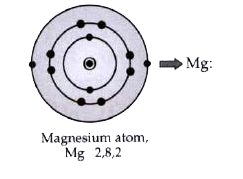Write the electron dot structures of sodium, oxygen and magnesium.
(a) Electron - dot structure for Sodium :

(b) Electron - dot structure for Oxygen:

(c ) Electron - dot structure for Magnesium :

Topper's Solved these Questions
- METALS AND NON-METALSBook:OSWAL PUBLICATIONChapter:METALS AND NON-METALSExercise:NCERT Corner (Exercise Questions)
Explore 22 Videos
- METALS AND NON-METALSBook:OSWAL PUBLICATIONChapter:METALS AND NON-METALSExercise:NCERT Exemplar (Multiple Choice Questions)
Explore 36 Videos
- METALS AND NON-METALSBook:OSWAL PUBLICATIONChapter:METALS AND NON-METALSExercise:Self - Assessment - 1 (Very short answer types questions)
Explore 3 Videos
- METALS AND NON - METALS Book:OSWAL PUBLICATIONChapter:METALS AND NON - METALS Exercise:CASE - BASED MCQs
Explore 29 Videos
- NEW CHAPTERS AND QUESTIONS BASED ON LATEST TYPOLOGIES INTRODUCED BY CBSE FOR 2021-22 EXAMINATION Book:OSWAL PUBLICATIONChapter:NEW CHAPTERS AND QUESTIONS BASED ON LATEST TYPOLOGIES INTRODUCED BY CBSE FOR 2021-22 EXAMINATION Exercise:PERIODIC CLASSIFICATION OF ELEMENTS (VISUAL CASE - BASED QUESTIONS)
Explore 15 Videos
Similar Questions
(i) Write the electron-dot structures for sodium, oxygen and magnesium.
(ii) Show the formation of Na2OandMgO by the transfer of electrons.
View Solution(i) Write the electron-dot structures for sodium, oxygen and magnesium.
(ii) Show the formation of Na2O and MgO by the transfer of electrons.
(iii) What are the ions present in these compounds?
View Solution
Knowledge Check
Draw the electron dot structures for
Aethanoic acidBH2SCpropanoneDF2
(i) Write the electron-dot structures for sodium, oxygen and magnesium.
(ii) Show the formation of Na2O and MgO by the transfer of electrons.
(iii) What are the ions present in these compounds?
View Solution(i) Write the electron-dot structures for sodium, oxygen and magnesium. (ii) Show the formation ofNa2O and MgO by the transfer of electrons. (iii) What are the ions present in these compounds ?
View SolutionGive its electron-dot structure.
View Solution(a) Give the electronic configurations of sodium and chlorine.
(b) Write the electron-dot structures for sodium and chlorine atoms.
(c) Describe the formation of sodium chloride from sodium and chlorine by the transfer of electrons. What changes take place in the electronic configurations of sodium and chlorine during the formation of sodium chloride?
(d) Write any two properties of ionic compounds.
View SolutionDraw the electron dot structures for
F2
View Solution(a) Give the electron configuration of magnesium and chlorine.
(b) Write the electron-dot structures of magnesium and chlorine atoms.
(c ) Describe the formation of magnesium chloride from magnesium and chloride formed ?
(e) Why do such compounds have high melting points ?
View Solution(a) Write the electron dot structure for calcium and oxygen. The atomic numbers of calcium and oxygen are 20 and 8 respectively.
(b) Show the formation of calcium oxide by the transfer of electrons.
(c) Ionic compounds are high melting solids. Give reason.
View Solution